Sign up for The Wild
We’ll help you find the best places to hike, bike and run, as well as the perfect silent spots for meditation and yoga.
You may occasionally receive promotional content from the Los Angeles Times.
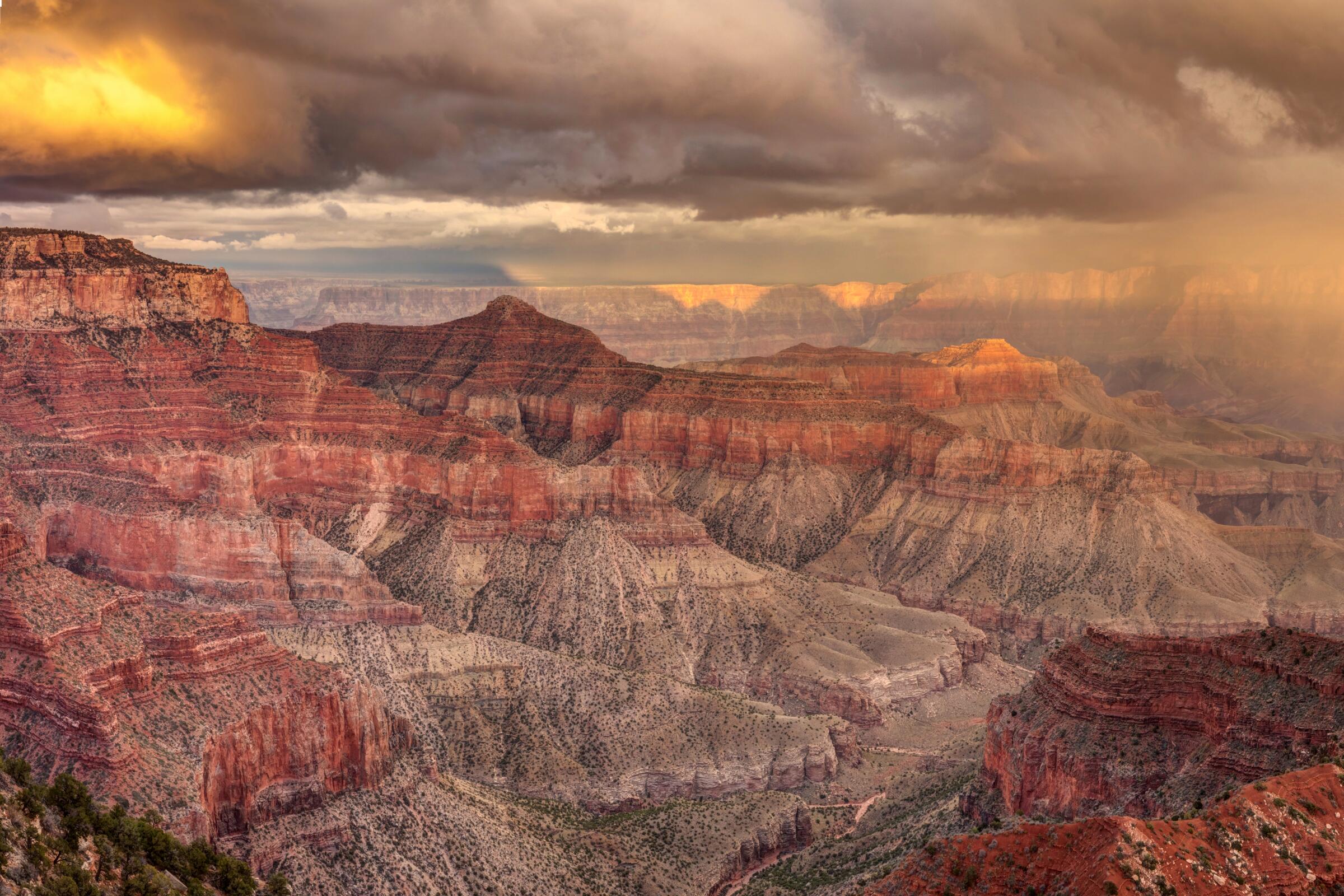
No photograph, however stunning, can do justice to the Grand Canyon. No account, however eloquent, can describe it in sufficient detail. To appreciate its grandeur, you must see it for yourself.
This year, I did just that. I stood, slack-jawed, on the South Rim, trying and failing to compute. I camped on the ice and snow of the North Rim, trying and failing to sleep. I was burned by the late-spring sun as I hiked the North Kaibab Trail. Even now, I’m plotting next year’s rim-to-rim hike. I’ve had a taste and I want more.
The Grand Canyon is an unfolding mystery. Since the park opened 100 years ago, more than 200 million visitors have made the pilgrimage to this chasm.
To get you started on your journey, here are 100 things you’ll want to know before you go, from A to Y (we couldn’t come up with a Z).
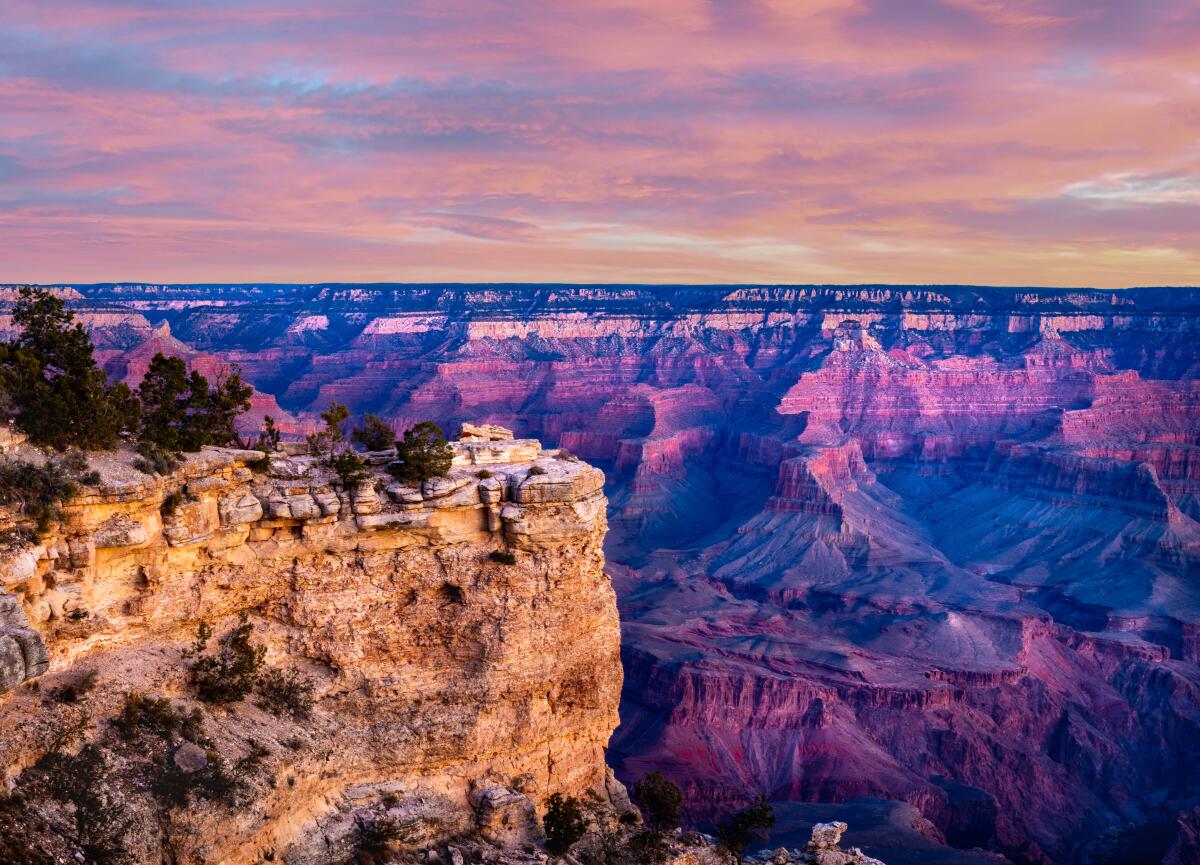
The South Rim is open year-round. The North Rim is open May 15 to Oct. 15; during winter, it may be accessed for day use on foot, skis or snowshoes as long as Arizona 67 remains open. All overnight hikers require permits ($10 per permit plus $8 per person), which may be purchased at the Backcountry Information Center, open 8 a.m.-5 p.m.
Grand Canyon Scenic Airlines runs a South Rim Airplane Tour (40-45 minutes) departing from the Grand Canyon National Park Airport. Sights include Zuni Corridor, Point Imperial, Kaibab Plateau and the confluence of the Colorado and Little Colorado rivers.
Cost, info: From $134, South Rim Airplane Tour
The park is home to 22 species of bats. The most common is the Western pipistrelle. The Bat Cave on the canyon’s West Rim5contains a large bat colony but is closed to the public. Don’t worry, though: If you take an overnight rafting trip (see No. 95) along the Colorado River, you are all but guaranteed to see bats flitting around.
Bighorn sheep are the largest native animal in the Grand Canyon. These nimble-footed creatures inhabit the park’s steep and rocky terrain and are often spotted in the side canyons along the Tonto Platform beneath the South Rim.
Grand Canyon Conservancy offers a one-day birding class and hike (May 18) in the forest and wetland close to Grandview Point; It’s also running a rim-to-rim birding backpack tour (May 19-24). There are 373 species of bird in the park; keep an eye out for chickadees, nuthatches, ravens, hawks, tanagers, phoebes and flycatchers.
HawkWatch International, a conservation organization based in Salt Lake City, holds free daily raptor viewing parties at Yaki Point on the South Rim (9 a.m.-5 p.m. through Nov. 5). Look out for hawks, owls, vultures, eagles and endangered California condors. (See No. 10.)
More rustic and affordable than neighboring El Tovar, Bright Angel Lodge on the South Rim packs some historic punch. Designed by Mary Colter in 1935, the property includes cozy motel-style rooms, a small museum and about 50 pinewood cabins.
Cost, info: Rooms from $174; Bright Angel Lodge
The 15.6-mile Bright Angel Trail is the most popular trail on the South Rim, is well maintained and has easy access to hotels, clean drinking water, rest houses and emergency phones. It’s the safest route in and out of the canyon, especially advisable during the summer heat.
The 292 species of butterfly in the Grand Canyon inhabit all areas of the park. They are usually spotted during summer and vary enormously in size. The Western pygmy blue butterfly has a wingspan of only a half-inch; the two-tailed swallowtail, said to be North America’s largest butterfly, has a wingspan of up to 6½ inches.
If you’re lucky, you might catch a glimpse of this endangered scavenger, complete with beady eyes and a 10-foot wingspan, wheeling over the canyon. The California condor is the largest of all flying North American birds. You’re most likely to spot one April through September from the South Rim. Some of the best viewing locations are Yavapai Point, Yaki Point and Lookout Studio. To learn more, attend a ranger-led condor talk at the South Rim Village amphitheater, or at the North Rim Campground amphitheater.
Bright Angel Campground (open year-round; backcountry permits required: $10 per group, plus $8 per person) is the largest, best-equipped camping location on the canyon floor. Set on the banks of Bright Angel Creek, half a mile from the Colorado River, it’s within easy reach of Phantom Ranch, where cold beer and ice cream mitigate the summer heat. There are two smaller camping options at the bottom of the canyon: Indian Garden Campground, 4.8 miles below the South Rim, and Cottonwood Campground, 6.8 miles below the North Rim.
North Rim Campground (open May 15 to Oct. 31; $18-$25 per night) is one of the best camping options in the park. Set among Ponderosa pines and aspen firs, it feels cozy and remote but is just a mile from the Grand Canyon Lodge and the North Rim Visitor Center. The smaller Tuweep Campground (backcountry permits required: $10 per group, plus $8 per person) is more difficult to access, but there’s a payoff: stunning canyon views at nearby Toroweap Overlook.
Mather Campground (open year-round; $18 per night) is the biggest and busiest campground in the park and within easy reach of restaurants, shops and viewpoints in Grand Canyon Village. For a more peaceful experience (minus the convenient amenities), choose Desert View Campground (open mid-April to mid-October; $12 per night), a first-come first-served campground near the spectacular Desert View.
This four-mile out-and-back hike goes to Cape Final, one of the most mesmerizing lookout points on the North Rim. The viewpoint stands at 7,916 feet and overlooks Vishnu Temple, Jupiter Temple and the eastern Grand Canyon. One Cape Final camping permit per night is issued by the Backcountry Information Center.
Info: Backcountry Information Center
Grand Canyon National Park has about 1,000 caves. Cave of the Domes is the only one currently open to the public and is accessed by the Grandview Trail. Look for vintage graffiti on the limestone walls; some of it dates to the 1800s.
This pioneering geologist (and close associate of John Wesley Powell, see No. 43) named some of the canyon’s most prominent natural formations after Hindu and Eastern deities. These include Shiva Temple, Vishnu Temple and Zoroaster Temple.
About 6 million people visit the Grand Canyon each year. Fortunately, the park is spread over about 2,000 square miles (about the size of Delaware), so there’s plenty of chance for peace and solitude. There are several ways to avoid the crowds. First, visit the park in spring, fall or winter. Second, eschew the busy South Rim in favor of the more tranquil North Rim. And third, venture inside the canyon on a day hike or a rim-to-rim hike. (See No. 76.)
About 12 people die each year in the Grand Canyon. Causes of death include drowning, falling, overheating and the selfie-related fatalities known colloquially as “killfies.” For more information on these fatal mishaps, consult Michael P. Ghiglieri’s “Over the Edge: Death in Grand Canyon.’”
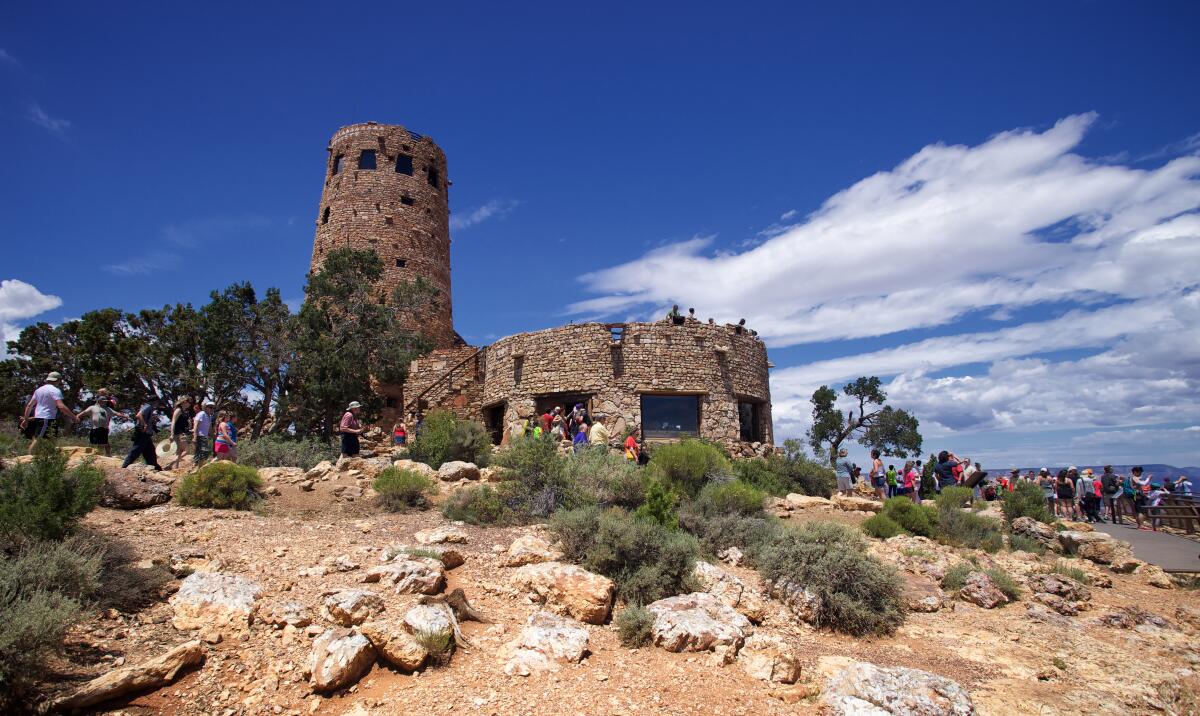
The stone Desert View Watchtower (1932) on the edge of the South Rim was designed by Mary Colter in the Ancestral Puebloan style. Climb the 85 steps to the 70-foot observation deck for panoramic views of the canyon and the Colorado River. You’ll find a deli, coffee shop and gift store. Open 8 a.m.-5.30 p.m.
The Grand Canyon is 277 miles long. Its widest point is 18 miles rim to rim and its deepest point is 1.15 miles.
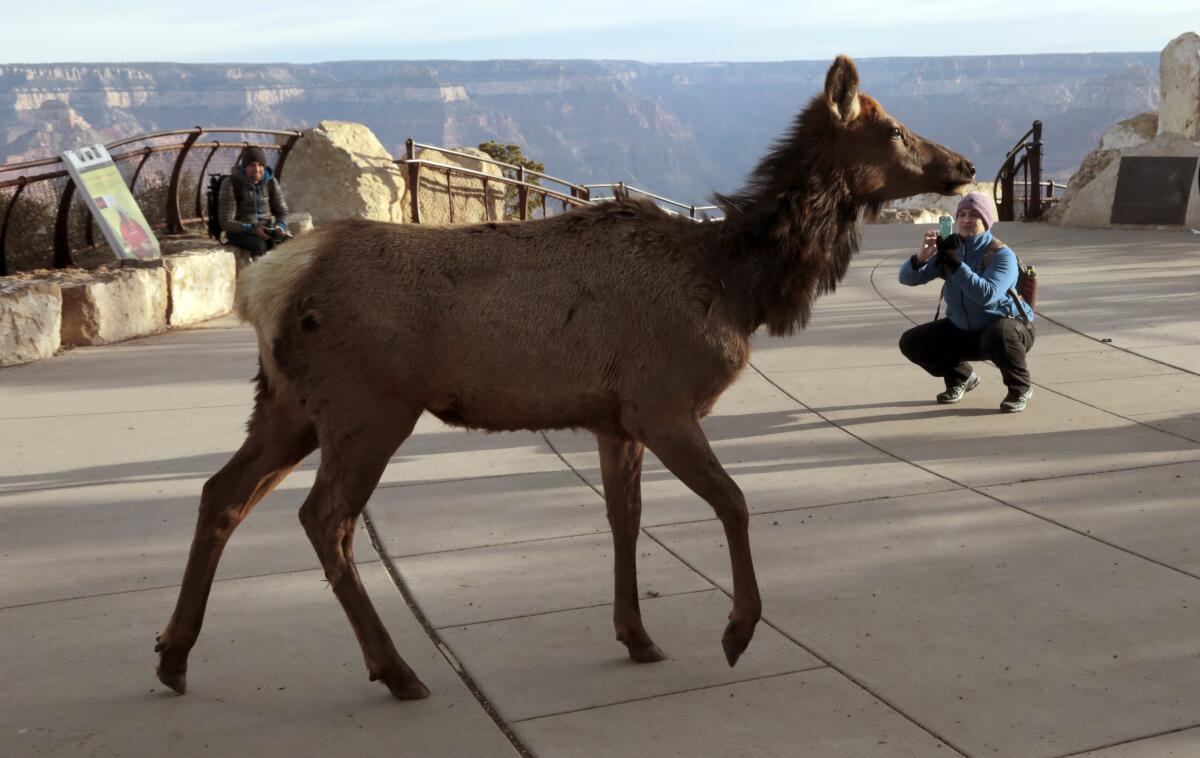
These graceful animals live in the canyon’s Ponderosa pine and pinyon-juniper forests and can sometimes be spotted nibbling on El Tovar’s manicured lawns. They also are one of the most dangerous creatures in the park. A bull elk can weigh up to 1,200 pounds (that’s heavier than a grizzly bear), so maintain a distance of at least 100 feet, and never get between a mother and her calf.
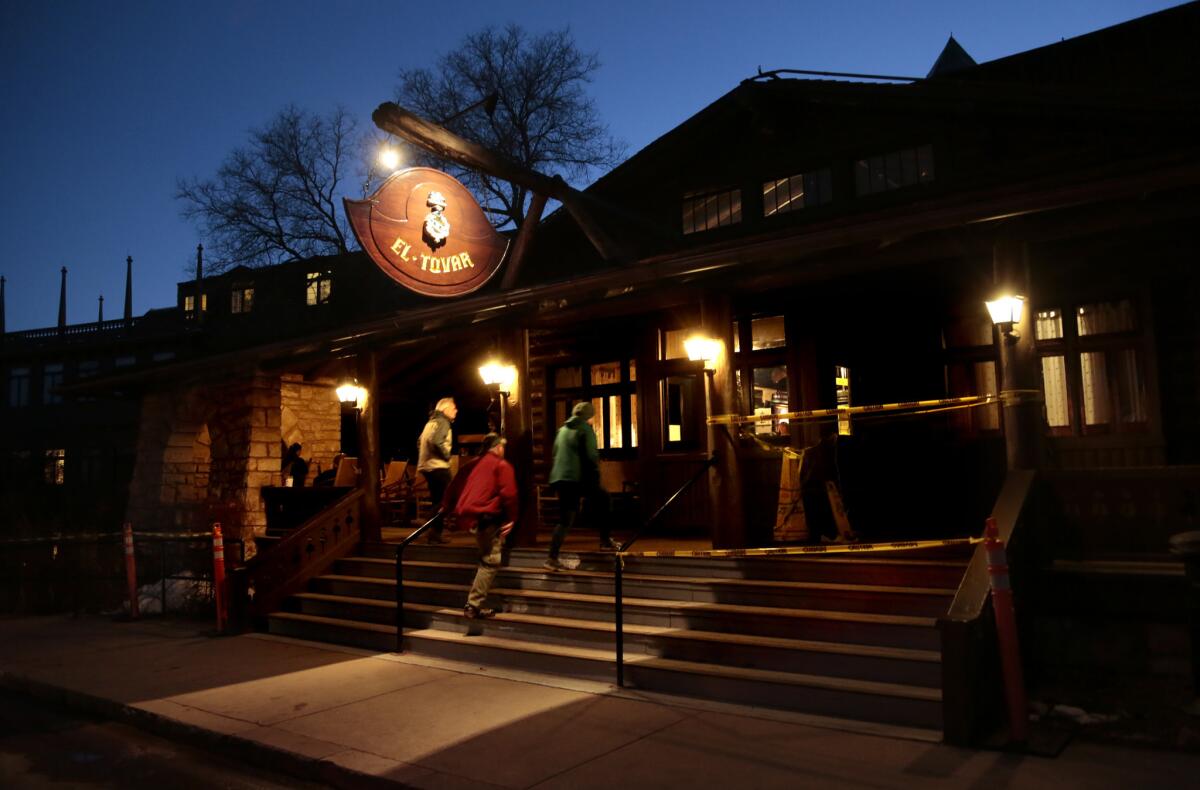
El Tovar, a National Historic Landmark, built in 1905 by Charles Whittlesey, sits 20 feet from the South Rim and has predictably mind-bending views. It’s the canyon’s most upscale lodging; former guests include President Theodore Roosevelt, Albert Einstein and Paul McCartney.
Cost, info: Rooms from $337 a night, El Tovar
There are many endangered, threatened and vulnerable species living within Grand Canyon National Park, including the humpback chub, Colorado squawfish, Mexican spotted owl, willow flycatcher and one of the rarest birds in the world, the California condor. (See No. 10).
Flash floods can occur any time of year, but are most common from July to September when thunderstorms are more frequent. Before hiking in slot canyons, check the weather forecast and consult a map for possible escape routes. For more information, go to the park website’s weather dangers.
When hiking in the canyon, choose salty, high-protein snacks such as energy bars, salted nuts and jerky. These help replenish the salt you lose in the heat of the day and guard against hyponatremia. For special occasions, look no farther than the dining room at the South Rim’s El Tovar. Order Chicken El Tovar with angel hair pasta and mushroom sherry sauce ($25.50), and don’t forget to treat yourself to a prickly pear margarita ($11).
Prescribed fires are useful in clearing dead vegetation, stimulating new growth and improving wildlife habitats. But some fires start accidentally. In July, the Ikes Fire started as a result of a lightning strike. The 15,000-acre-plus fire is still burning. Campfires are prohibited below the rim, and are limited to the designated fire rings within maintained campgrounds.
During a 1540 expedition through the American Southwest, this Spanish explorer and his men were the first Europeans to see the Grand Canyon and the Colorado River. Arriving at the South Rim, they tried but failed to venture into the canyon.
This Dutch geologist completed the first topographic maps of the canyon. The North Rim’s François Matthes Trail is a pleasant five-mile hike through pine forests and open meadows.
The canyon’s layer-cake geology reveals about 1.2 billion years of stratified rock, including granite, sandstone and limestone. The oldest and deepest rock layer in the Grand Canyon is known as Vishnu Schist. Kaibab Limestone, the youngest, is a mere 270 million years old.
Twenty-five minutes’ drive from the South Rim entrance, the new Under Canvas campground features luxury tents with en-suite bathrooms, organic bath products and private decks. There’s even on-site dining, so you can trade your sausage and beans for pan-roasted trout with wild rice and seasonal vegetables.
Cost, info: From $164 per night, Under Canvas
Partnering with the National Park Service, Grand Canyon Conservancy Field Institute’s team of experts leads guided trips, classes and educational tours in art, history, photography and geology. Its youth program provides summer camps, day trips and university internships.
The Grand Canyon Lodge, a large hotel and cabin complex completed in 1928, is the only North Rim lodging. Rooms sell out quickly, with good reason. The Rim View Western cabins feature private porches with unobstructed canyon views.
Cost, info: From $146 a night, Grand Canyon Lodge
The Grand Canyon Trust, a nonprofit conservation organization established in 1985, aims to protect the culture, environment and wildlife of the Grand Canyon and the Colorado Plateau. To learn more, to volunteer or to donate, visit Grand Canyon Trust.
A trip to the South Rim’s visitor center is an excellent introduction to the park. An interactive exhibition showcases the canyon’s rich history and geology (including a 20-minute movie titled “Grand Canyon: A Journey of Wonder”). There’s also a gift store, a bookshop and a cafe. Bikes are available to rent March through November. Open daily (May to September, 8 a.m.-6 p.m.; October-April, 8 a.m.-5 p.m.).
This Swedish American artist’s landscape paintings brought tourists to the Grand Canyon during the ’20s and ’30s. These days, you can tread in Gunnar’s hallowed footsteps along one of his favorite North Rim hikes, the Widforss Trail.
Hang gliding is forbidden in Grand Canyon National Park, but this wasn’t always the case. On May 9, 1976, park authorities permitted four men to try a Hang Gliding Feasibility Test from the South Rim. The flight took place without problems or injuries, but (perhaps rather sensibly) the powers that be decided to ban the sport indefinitely.
These are the first of five eye-popping turquoise waterfalls on the Havasupai Indian Reservation. This year the tribe has banned commercial tours to the falls, so the only way to access them is to reserve a stay through its website. It’s a 10-mile hike into the canyon, so be prepared for the long haul. Failing that, it’s a 10-minute helicopter ride to Supai Village, two miles from the campground ($85 one-way per person).
Staying safe in the Grand Canyon usually amounts to simple common sense. Don’t climb over railings at viewpoints, watch your footing on steep hiking trails, drink plenty of water and maintain a healthy distance from wildlife (50 feet for small mammals and reptiles, 100 feet for deer, elk, bison and condors). For more information, go to the park website’s safety page.
Maverick Helicopters offers flights departing from Grand Canyon South Rim terminal ($299 per person). The trip is 45-50 minutes, with views of Marble Canyon, Point Imperial and the confluence of the Colorado and the Little Colorado rivers.
There is spotty internet and cellphone coverage in the North Rim and South Rim visitor centers and in some of the larger hotels, including El Tovar and Grand Canyon Lodge. But if you venture inside the canyon, assume you’ll be incommunicado. Always inform a friend or family member about where you’re going and for how long.
Grand Canyon Jeep Tours runs a sunset tour (adults $95; children $80) to Grandview Point on the South Rim. Alternatively, Grand Canyon Custom Tours offers a tour to the bottom of the canyon (adults $269; children $209) descending at Peach Springs, near the Western Rim, and following Diamond Creek to the Colorado River.
In 1873, this Mormon missionary established a ferry crossing called Lee’s Ferry (see No. 47 ) near the entrance to the park. Lee was later executed for his role in the Mountain Meadows massacre in southern Utah, in which 120 Eastern emigrants were slain.
In 1869, this one-armed Civil War veteran led a team of 10 men on a U.S.-government-sponsored expedition along the Colorado River. He is credited as the first European American to cross the length of the Grand Canyon. The Powell Plateau on the North Rim is named in his honor.
In 1857, this American soldier and explorer was the first European American to reach the river in present-day Grand Canyon National Park. “Ours has been the first, and will doubtless be the last, party of whites to visit this profitless locality,” he wrote. “It seems intended by nature that the Colorado River … shall be forever unvisited and undisturbed.”
Kachina Lodge, a 1960s motel-style lodge, is on the Rim Trail and within easy walking distance of the Kolb Studio and the Bright Angel trailhead. It offers well-appointed rooms, many with partial canyon views.
Cost, info: Rooms from $249 per night, Kachina Lodge
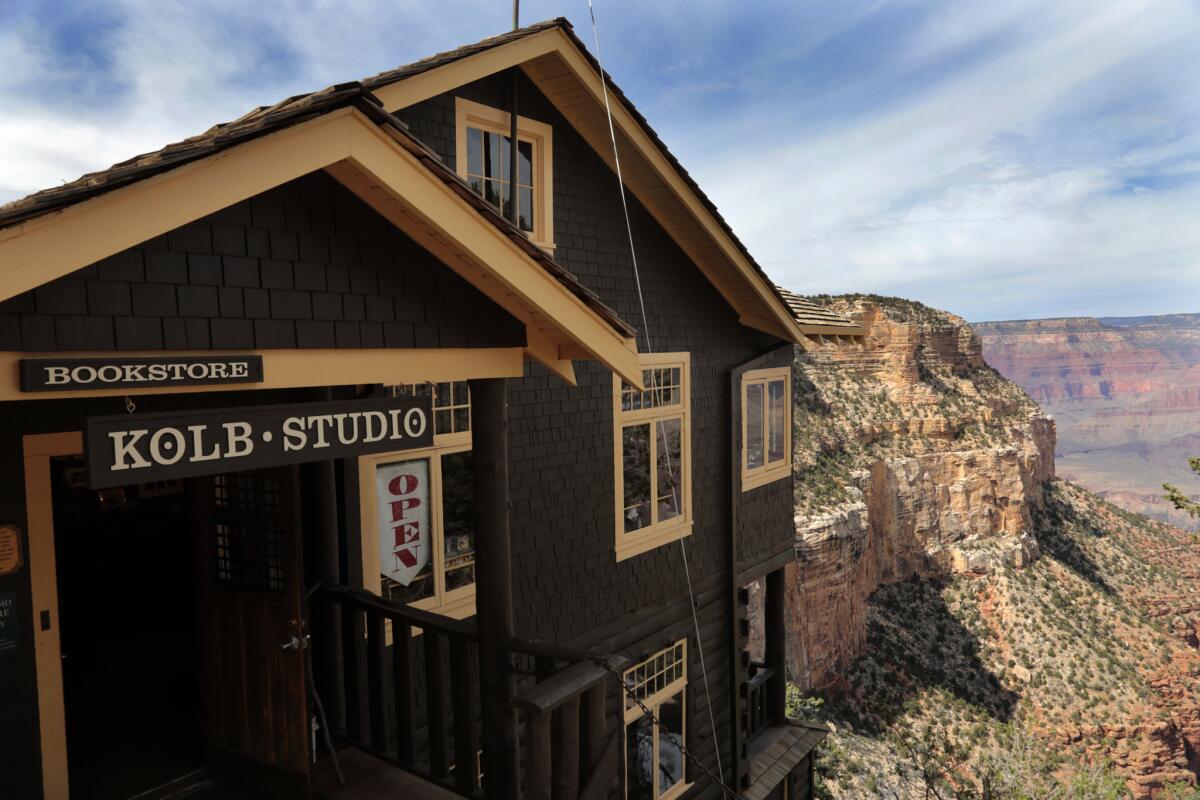
The former home and studio of Ellsworth and Emery Kolb, pioneering photographers, is a ski chalet-style structure on the South Rim near Bright Angel Lodge. It was built in 1905 and now is a bookstore and museum, with rotating art and photography exhibitions.
Cost, info: Open 8 a.m.-7 p.m. daily. Free admission, Kolb Studio
Lee’s Ferry (or Lees Ferry), with the only direct access to the Colorado River for hundreds of miles, is an important launching point for fishing and rafting expeditions. The ruin of John D. Lee’s (see No. 42) ranch, Lonely Dell, is still here. There’s a self-guided walking tour of the orchard, cabins, ranch and cemetery.
He Travel offers a nine-day rafting vacation on the Colorado River called Splash! Gay Grand Canyon Rafting Adventure. The trip starts at Lees Ferry, passes through Lava Falls (the most challenging rapids in the canyon) and ends at Lake Mead. There are multiple trips May through September and a women-only trip June 17-26.
Cost, info: $3,998 per person, Splash Rafting Trip.
Eighteen species of lizards inhabit the Grand Canyon, including the yellow-backed spiny lizard, the greater short-horned lizard and the collard lizard. They’re all harmless, except for the venomous Gila monster, which can grow up to 22 inches long and weigh as much as 5 pounds. This lizard is easily identified by its black and orange markings; if you spot one, stay at least 15 feet away.
Lookout Studio, perched on the edge of the South Rim, was designed in the Ancestral Puebloan style by Mary Colter. The outdoor terrace has coin-operated telescopes and is the ideal spot to catch a glimpse of the endangered California condor. Open 8 a.m.-8 p.m. daily.
Pittsburgh-born Mary Colter, probably the most noted female architect of her time, designed six buildings in the Grand Canyon: Hopi House (1905), Hermit’s Rest (1914), Lookout Studio (1914), Phantom Ranch (1922), Desert View Watchtower (1932) and Bright Angel Lodge (1935).
Maswik Lodge, a basic yet friendly hotel, is set in a Ponderosa pine forest a quarter mile from the South Rim. Some rooms feature two queen-size beds, a good setup for traveling families. There are affordable food options on-site, including the Maswik Food Court and Pizza Pub.
Cost, info: Rooms from $245, Maswik Lodge
REI offers a six-day biking adventure on some famous Arizona trails, including the Rainbow Rim Trail, a single-track path that skirts the Grand Canyon’s North Rim. The route features overlooks at Locus Point, Fence Point and Parissawampitts Point. Departures May-September.
Cost, info: $1,949 per person, Grand Canyon Biking
Commercially guided rock climbing and canyoneering tours are not permitted in the park. But that doesn’t stop private groups from climbing many of the Grand Canyon’s most prominent landmarks, including Vishnu Temple and Zoroaster Temple. For more information on canyoneering in the park’s slot canyons, consult Todd Martin’s “Grand Canyoneering: Exploring the Rugged Gorges and Secret Slots of the Grand Canyon.”
Mountain lions are the top predator in the Grand Canyon, can grow to 8 feet long (nose to tail) and reach speeds of up to 45 mph. They prey on elk, mule deer and bighorn sheep as well as smaller animals such as fox and wild turkey. If you come face to face with an aggressive mountain lion, don’t run; stand tall, make noise and fight back.
Mule deer are the most frequently sighted large mammal in the Grand Canyon. They’re more common on the North Rim, but can be spotted in all areas of the park, including forest hiking trails, desert scrub and on the banks of the Colorado River. They are easily identified by their large ears and black-tipped tails.
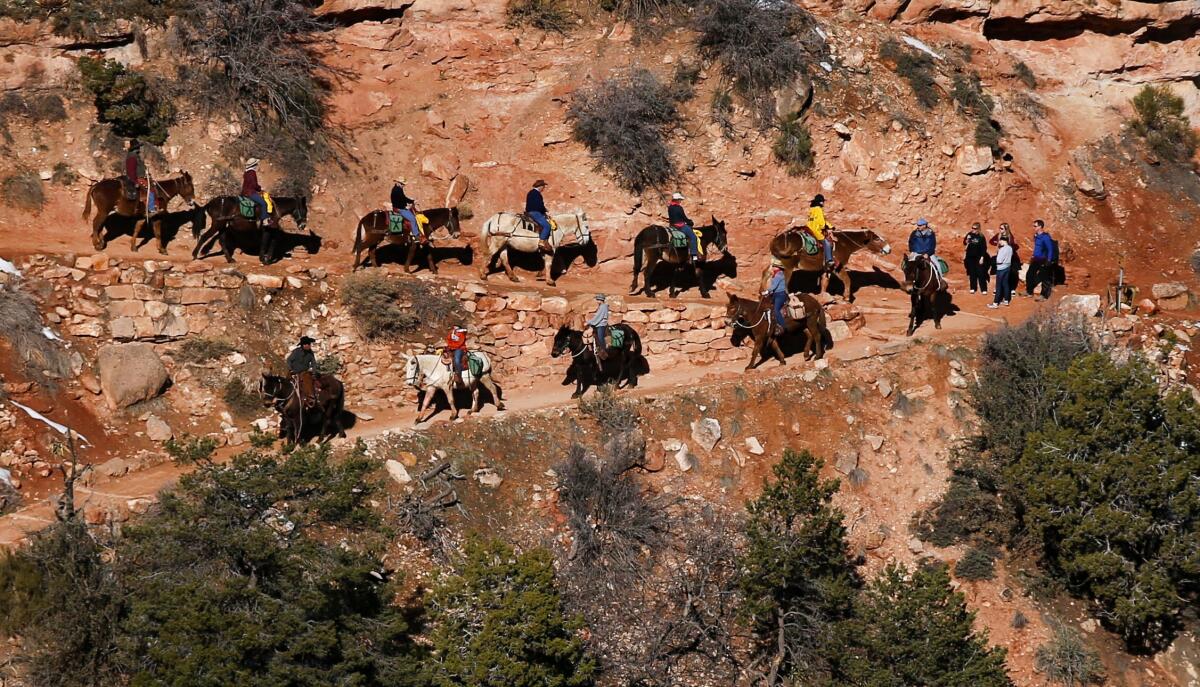
Mule rides have been a Grand Canyon fixture since 1887. For North Rim rides ($45 per person for a rim tour; $90 per person for a canyon tour) contact Grand Canyon Trail Rides. For South Rim rides (starting at $142.83 per person) contact Xanterra. These tours are often booked more than a year in advance. The popular mule ride to Phantom Ranch is booked through an online lottery.
There are hundreds of ruins and rock art sites in the canyon. Keep your eyes open for pictographs in the limestone near the first tunnel on the Bright Angel Trail. Or hike to the panel of abstract pictographs at Shaman’s Gallery, accessible through Tuckup Canyon. OARS offers a weeklong rafting trip from Lee’s Ferry to Phantom Ranch, featuring a hike to Ancestral Puebloan ruins at Nankoweap Canyon.
Cost, info: $2,775 per person, Oars rafting trip
Six Native American tribes live in and around the canyon: the Hualapai, Havasupai, Navajo, Paiute, Hopi and Zuni. Many Grand Canyon landmarks, including Havasu Falls and Ribbon Falls, are sacred sites for tribes.
On June 30, 1956, a United Airlines Douglas DC-7 and a TWA Lockheed L-1049 collided above the Grand Canyon, killing all 128 passengers on board. The tragedy led to the creation of the independent Federal Aviation Administration, responsible for civil aviation safety.
Be prepared for a steep and strenuous 28-mile round trip from the North Rim on the North Kaibab Trail. Hikers generally spend three to four days on this most challenging of the canyon’s maintained trails, which passes through every ecosystem found between Canada and Mexico. Cool off along the way at Ribbon Falls and Roaring Springs, two magnificent waterfalls.
Kaibab Lodge no longer runs skiing tours. But private groups are permitted to ski on the North Rim by obtaining permits from the Backcountry Information Center.
Viewpoints on the North Rim are higher and quieter than their southern neighbors. With blissful views of the San Francisco Peaks, Bright Angel Point near Grand Canyon Lodge is a good place to start. Afterward, follow Arizona 67 to Point Imperial, the highest overlook (8,803 feet) in the Grand Canyon. Farther afield is Toroweap Overlook, a lonely outpost with unobstructed views of the Colorado River. The downside? It can be accessed only by a bumpy 60-mile dirt road.
The visitor center here is smaller than the one on the South Rim. You’ll find an informative permanent exhibition and a thoughtfully curated bookstore. Meals and snacks are available at the nearby Grand Canyon Lodge.
Award-winning California landscape painter Bill Cramer offers a three-day outdoor oil painting workshop on the South Rim (June 5-7; $850 per person, bit.ly/billcramerpainting). From Sept. 21-25, Mitch Baird will offer plein air painting sessions at Hopi Point, Pima Point, Trailview Overlook and Mohave Point. $675 per person; Plein air painting
Leashed pets are welcome along the entire 13-mile South Rim Trail. Mather campground, Desert View campground, Trailer Village and Yavapai Lodge are all pet-friendly overnight options. Animals can be boarded at the South Rim’s Grand Canyon Kennel. Proof of vaccination must be provided. $22 per day; $26.50 per night for dogs less than 50 pounds; $30 per night for dogs heavier than 50 pounds.
Phantom Ranch, the Mary Colter-designed lodge (1922) on the northern bank of the Colorado River, is the only lodging on the canyon floor. As such, it is accessible only to hikers and mule riders and is usually booked a year in advance. Beginning this year, reservations can also be made through a lottery.
Cost, info: Cabins from $169; dorm beds $65, Phantom Ranch
Backcountry Journeys offers a seven-day photography vacation: Southwest Monsoon: Grand Canyon Country (July 25-31) led by Kenton Krueger, a professional photographer and guide. This tour promises dramatic photos of summer thunderstorms in Horseshoe Bend, Lake Powell and Grand Canyon’s North Rim.
Cost, info: From $3,695 per person, Monsoon photo trip
There are more than 1,700 species of plants in the canyon. Some of the most common are cliff rose, yucca, desert sumac, Utah juniper and Arizona ephedra, also known as Mormon tea. Some canyon plants are edible, including banana yucca, currant bush and the fruit of the cereus cactus.
As a senator, Harrison introduced the first bill to create Grand Canyon National Park in 1882 and again in 1883 and 1886. These bills failed. But as president, he was able to establish the Grand Canyon Forest Reserve in 1893, a significant step toward creating the park we know today.
In 1908 Roosevelt declared the 800,000 acres of the Grand Canyon a national monument. “Let this great wonder of nature remain as it now is,” he wrote. “You cannot improve on it. But what you can do is keep it for your children, your children’s children, and all who come after you, as the one great sight which every American should see.”
In 1919, Wilson established Grand Canyon National Park. Since then, more than 200 million people have visited. The park has remained open every day for 100 years, even during the partial government shutdown that began Dec. 22, 2018, and lasted for 35 days.
Since the late 1800s, the Grand Canyon railway has carried passengers from Williams, Ariz., to the South Rim’s train depot. It’s a pleasant ride through Ponderosa pine forests and wide-open prairies. You won’t see the canyon from the train.
Cost, info: $82-$226 round-trip per person, The train
There are six species of rattlesnake in the park, including the Grand Canyon pink rattlesnake, found nowhere else in the world. Rattlesnakes are venomous but rarely strike humans unless provoked or startled. If you hear a rattle, move away from the noise and observe the snake from at least 15 feet.
There are countless Grand Canyon guides, travelogues and historical accounts. Must-reads include John Wesley Powell’s “The Exploration of the Colorado River and Its Canyons” (1875); Stephen J. Pyne’s “How the Canyon Became Grand: A Short History” (1999); and James Kavanagh’s “Field Guide to the Grand Canyon: A Folding Pocket Guide to Familiar Plants and Animals” (2017).
The classic Grand Canyon rim-to-rim hike usually begins on the North Rim and ends on the South. The record for this 21-mile route is two hours 39 minutes, but the beauty of the canyon is best enjoyed with more time. OARS offers a five-day rim-to-rim adventure with two nights at the Phantom Ranch.
Cost, info: $2,499 per person, Rim-to-rim adventure
The popular paved South Rim trail (open year-round) starts at Hermit’s Rest and ends at the South Kaibab trailhead. Bikes and leashed pets are permitted along the 13-mile path.
The three RV parks closest to the South Rim are Mather, Trailer Village (RV hookups) and Desert View. On the North Rim (open May 15 to Oct. 15) options include North Rim Campground, Kaibab Camper Village and DeMotte Campground. These parks get very busy, especially in the summer, so arrive before 9 a.m. for your best chance of securing a spot. You can buy your vehicle pass online for $35.
Paragon Skydive offers a tandem skydiving experience with bird’s-eye views of the Grand Canyon. The trip, which includes about 40 seconds of free fall, starts and ends near the main terminal of the Grand Canyon National Park Airport.
Cost, info: From $299 per person, skydiving experience
In 2007 the Hualapai tribe approved the construction of Skywalk, a bridge with a glass walkway jutting 70 feet into the canyon, at Eagle Point in Grand Canyon West. Tickets start at $69 per person, which includes shuttle bus service and access to Guano Point, Eagle Point and Hualapai Ranch viewpoints.
This 14.6-mile ridge-line trail features gob-smacking canyon views in all directions. But beware: There is no water and you’ll find very little shade. It’s the fastest route to the canyon floor and ends at Kaibab Suspension Bridge, near Bright Angel Campground and Phantom Ranch.
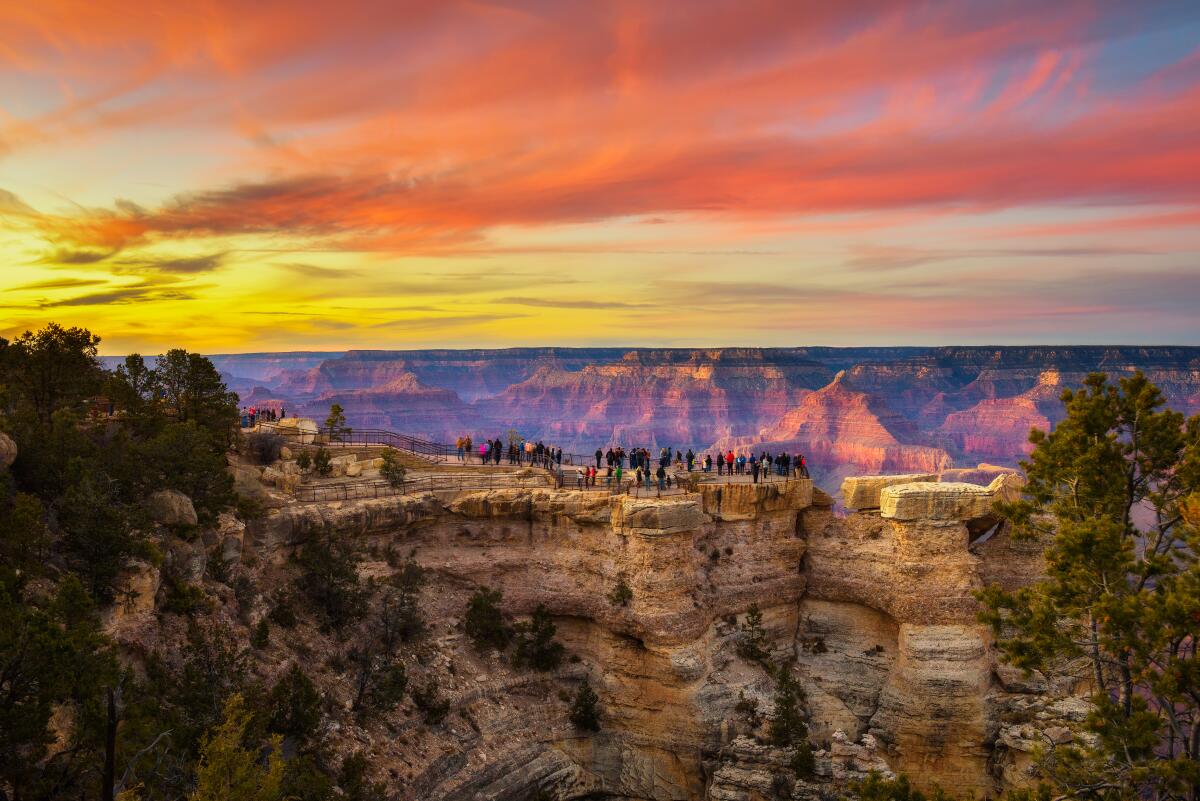
There are more than 50 viewpoints along the South Rim. Give busy Mather Point (near the visitor center) a wide berth and head instead to Desert View at the park’s east entrance. Here, climb Desert View Watchtower for 360-degree views, then drive 23 miles to Yavapai Point to learn more about the canyon’s 1.2 billion-year history at Yavapai Geology Museum (see No. 99). Finally, drive five miles to Hopi Point. This overlook juts farther into the canyon than any other section of the South Rim, perfect for watching the sunset.
The Kaibab squirrel lives in the pine forests of the North Rim. The Abert’s squirrel inhabits the South Rim. Squirrels may look cute, but they can be aggressive, and some carry rabies, bubonic plague and hanta virus. The park website recommends you stay about 15 feet from small mammals.
Grand Canyon Star Party celebrates its 30th anniversary June 13-20. Telescopes will be set up on the terrace of the North Rim’s Grand Canyon Lodge and the South Rim’s Grand Canyon Visitor Center. June is the clearest month of the year, so expect to be wowed by the mighty cosmos.
You read that right. Canyon Explorations’ 15-day musical adventure (next available trip June 2022) features performances by a Seattle Symphony string quartet. Enjoy sunrise and sunset recitals of Bach, Haydn and Dvorak in the canyon’s natural auditoriums. The ensemble has even been known to give concerts on a river raft.
Cost, info: From $4,575 per person, Musical Canyon
Wear a hat and sunglasses. And don’t forget to apply sunscreen regularly. In the summer months, the park website recommends you avoid hiking between 10 a.m. and 4 p.m.
During the winter, temperatures can dip below 20 degrees on the South Rim; during the summer, they can soar above 120 on the canyon floor. Check the park website for more information on seasonal weather conditions.
To ensure safe hiking in the canyon, always bring the 10 essentials. This list of must-haves was devised in 1974 by the Mountaineers, a nonprofit outdoor community in the Pacific Northwest. The list: navigation device, headlamp, sun protection, first aid, knife, fire, shelter, extra food, extra water and extra clothes. For more information and a detailed list, go to The Mountaineers.
The Thunderbird Lodge, a 1960s hotel offers, all the creature comforts: in-room coffee maker, small refrigerator, television and private bathroom. It’s a quick stroll to the restaurants at Bright Angel Lodge and El Tovar.
Cost, info: Rooms from $224, Thunderbird Lodge
You’ll find more than 200 species of trees in the park, mostly in the forests of the North and South Rim. Look for Douglas fir, Fremont cottonwood and Ponderosa pine, easily identifiable by its bark’s rich butterscotch smell.
Walk the short trail through the remains of this 800-year-old Ancestral Puebloan village near the South Rim. Then learn more about its prehistoric inhabitants at the small museum. Ancient artifacts include 2,000-year-old split twig figurines. Entrance is free.
Pack at least 3 liters a day when hiking in the canyon; double that during the summer months. Collapsible water bottles are a good solution when you have the option to refill. Be aware that the only filling stations are on the Bright Angel Trail and the North Kaibab Trail. Otherwise, you will need to bring water with you or use filters to purify spring and river water.
Havasu Falls (see No. 37.) steals much of the glory, but there are dozens of other waterfalls to explore. Close to Havasu, you’ll find Mooney Falls and Beaver Falls. Equally impressive but farther afield are Deer Creek Falls, Elves Chasm and Thunder River. Alternatively, you can luxuriate in the 100-foot Ribbon Falls, just one of many stops on Wildland Trekking’s Phantom Ranch rim-to-rim three-day hike.
Cost, info: $1,530 per person, Phantom Ranch
Arizona Raft Adventures add ramps to motorized boats to allow easy wheelchair access for its white-water rafting trips; Papillon Helicopters accommodates disabled guests on all its Grand Canyon tours; and Grand Canyon Railway provides boarding assistance for mobility-impaired travelers. For more information, consult Candy B. Harrington’s “Barrier-Free Travel: The Grand Canyon for Wheelers and Slow Walkers.”
OARS offers a 10-day rafting adventure through 23 major rapids, including legendary Lava Falls, the most challenging section of the Colorado River in the Grand Canyon. The tour starts at Phantom Ranch and ends at Diamond Creek.
Cost, info: $4,369 per person, Oars white water
Spring is wildflower season in the Grand Canyon. The park has about 650 kinds of herbaceous wildflowers. Look for flowering prickly pear cactus, globemallow, desert phlox and golden columbine. And don’t miss the purple redbud trees and the bright-red ocotillo that occupy the banks of the Colorado River in April and May.
In April 2015, Dr. Glenn Singleman and his wife, Heather Swan, were the first to fly across the Grand Canyon in a wingsuit. Commercial wingsuit tours are (mercifully) prohibited.
REI offers a four-day women’s backpacking adventure from the South Rim. The tour includes yoga and meditation sessions, flora and fauna identification, and instruction in backcountry and survival skills.
Cost, info: From $899 per person for REI members, $999 for non-members, REI women only
Topographic relief maps and 3-D models provide context and scale in this state-of-the-art museum and observation station. The large windows provide some of the best views of the South Rim and the Colorado River. Entrance is free.
Grand Canyon Conservancy offers a four-day yoga retreat (Feb. 11-14) with hikes along the Bright Angel Trail to Phantom Ranch. The tour will be led by certified yoga instructors Kelley Ingols and Sherri O’Neil.
Cost, info: $1,070 per person for members, $1,095 nonmembers, Conservancy yoga retreat
Sign up for The Wild
We’ll help you find the best places to hike, bike and run, as well as the perfect silent spots for meditation and yoga.
You may occasionally receive promotional content from the Los Angeles Times.